



NumisTip is being integrated into NumisBid. Click here to view this page on NumisBid
?
While not originally intended to be a
Coins were ordered for the years R.S. 127 (1908), 128 (1909) and 129 (1910) and while 1,036,691 one baht coins dated R.S.
127 were produced, they only arrived at Siam after the death of King Rama V on the 23rd of October 1910
(The Treasury Department, 2005)
. King Rama V's son and heir, King Vajiravudh (Rama VI) therefore ordered the production of commemorative cases
for the coins to be released at the Royal Cremation of King Rama V. It is estimated that about 10,000 pieces were distributed,
the remainder were probably melted. In addition to these, the Paris Mint sent a few samples of One Baht, Two Saleung and
One Saleung coins to King Rama V for approval. These were marked ESSAI, French for

The commemorative cases came in four forms, a two coin set showing each face of the coin, a one coin set showing the obverse up, a one coin plate with the coin embedded in the top-right hand corner showing the obverse up and a silk and velvet fabric case with the coin mounted in the upper-middle. The coins were distributed at the Royal Cremation of King Rama V with nobility of higher status being given the Royal Gift of the two coin case and nobility of lower status or public servants receiving the various single coin cases (The Treasury Department, 2005) .


The


The
The first and by far the most common type is the R.S. 127 (1908) dated business strike. These were the coins distributed at the Royal Cremation of King Rama V and form the bulk of what has survived today. The issue features the designer's privy mark A.PATEY on the left shoulder of King Rama V and due to the coins being pressed into their hard, silver presentation cases, the coin generally features a somewhat rough rim. Despite the relatively high mintage figure of over one million, it is estimated that only 10,000 have survived today, most of which are quite worn or otherwise damaged. The One Baht coin is 30mm in size, weighs 15 grams and was struck from 90% silver and 10% copper.
The Type I Essai Strike One Baht is dated R.S. 127 (1908) and features a brilliant finish similar to the circulation issue differing only with the placement of the designer's privy mark 'A PATEY' appearing near the rim at 8 o'clock on the obverse and the addition of the term ESSAI, meaning trial or test in French, at 4 o'clock on the reverse. This is the scarcer of the two R.S. 127 dated essai types.
The Type II Essai Strike One Baht is dated R.S. 127 (1908) and features a matte finish and is otherwise similar in design to the standard circulation issue except for the placement of the marker ESSAI on the reverse at 4 o'clock. While this is overall the easiest essai type moustache coin to acquire, it is by no means a common coin with only a handful of examples surviving.
Due to the very limited numbers of the R.S. 129 (1910) dated One Baht, it too is most likely an essai strike although it neither features the marker ESSAI or the designer's privy mark A.PATEY. This is the scarcest of the series but no examples are known in private hands.
The R.S. 128 (1909) dated Two Saleung was only issued as an essai strike and features the ESSAI imprint at 4 o'clock on the reverse and the A.PATEY privy mark on the left shoulder of King Rama V at 4 o'clock. The Two Saleung essai strke is slightly smaller than the one baht being only 25.4mm in size and weighing 7.23 grams.
The R.S. 128 (1909) dated One Saleung was also only issued as an essai strike and features the ESSAI imprint at 4 o'clock on the reverse and the A.PATEY privy mark on the left shoulder of King Rama V at 4 o'clock. The One Saleung essai strike is considerably smaller than the one baht being only 20mm in size and weighing 3.75 grams.
Like any key coin, modern counterfeits are to be expected so it is important to be able to familiarise yourself with the characteristics of authentic and counterfeit pieces. The first test as to whether a moustache coin is genuine is to check whether the coin is in medal die alignment or coin die alignment. Medal die alignment is where the obverse is at the same angle as the reverse (similar to modern British coins) while coin die alignment is where the obverse is rotated 180 degrees to the reverse (similar to modern American coins). All genuine examples are produced in coin die alignment and as many modern counterfeits are not, this is perhaps the easiest way to be certain a coin is a counterfeit.
The second test is to look at the lettering in the legends. Many of the modern counterfeits have sharp, thin lettering while original examples exhibit a thicker, softer lettering.

As you can see in the illustration, the counterfeit example (on top) has much thinner, sharper lettering than the authentic example. In addition, the P in PATEY is reversed on this counterfeit coin although this may not necessarily be the case on all counterfeit examples.
Another easy test is to check the weight of the coin. Most counterfeit examples will be struck from lighter metals to cut down on production costs - authentic examples should weigh 15 grams +/- 0.5g.
With an exception of the Essai strikes, authentic examples almost always have a rough and slightly beveled rim due to the hard cases that they were presented in. In addition to this, the coins were sent in bulk via ship from Paris to Siam. The long journey by sea contributed considerable bagmarks to the surfaces of the coins making examples with clear surfaces unlikely. A sharp, precise rim paired with clear, mark-free surfaces on a normal circulation one baht is almost certainly a sign that the coin is a modern reproduction.
While the Erawan elephant series One Baht, Two Salung and One Salung coins continued well into the reign of King Rama VI, the 1908 One Baht and various essai strikes are unique as they are the only examples of these coins to bear the portrait of King Rama V. In addition, their importance is further enhanced by their role at the Royal Cremation of King Rama V, being handed as a royal gift specifically to nobility. Their scarcity, combined with their royal heritage has ensured their strong demand rendering them the most popular Thai coin of the 20th century.
Find out what dealers are paying with a subscription.
Subscribe now!Find out what coins have actually sold for and where with a Standard/Professional subscription.
Subscribe now!